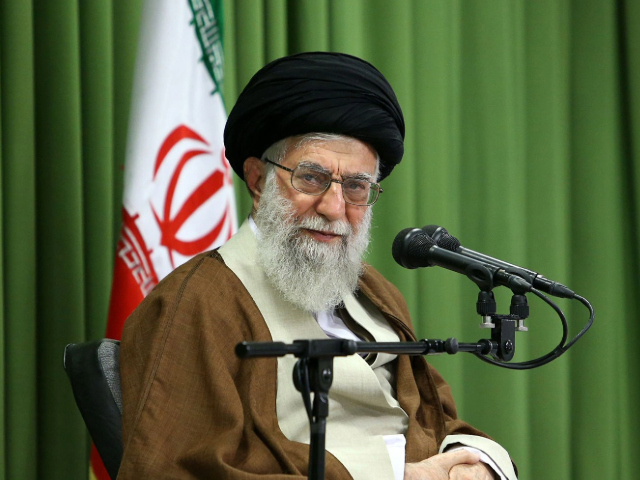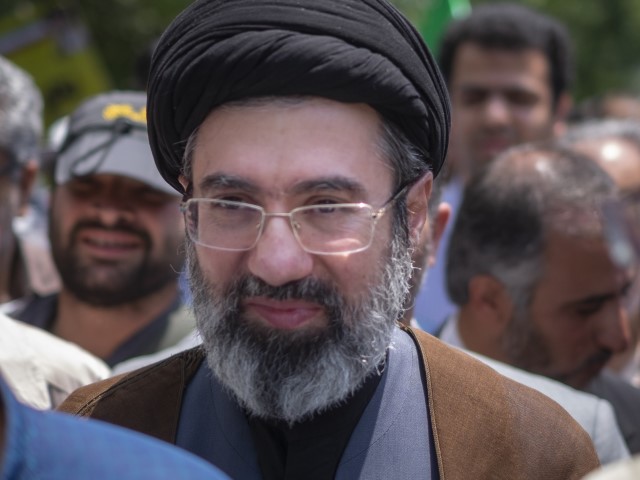Iran: President Raisi’s Death Shakes Up List of Contenders for ‘Supreme Leader’
The death of Iranian President Ebrahim Raisi in a helicopter crash this month has prompted two scrambles for power, both for power and for Raisi’s place as a leading candidate to succeed Ayatollah Ali Khamenei as “supreme leader.”
Under the rules of the Iranian theocracy, the “Supreme Leader“ is a Shiite Muslim cleric with dictatorial powers who directly controls the more powerful and aggressive wing of the Iranian military, the Islamic Revolutionary Guard Corps (IRGC), a U.S.-designated terrorist organization.
The Supreme Leader has final say on all domestic and foreign policies of any consequence, appoints most of Iran’s top officials, and manipulates much of Iran’s wealth through a series of phony “charitable trusts.” The interim president following Raisi’s death, Mohammad Mokhber, rose to power by managing the largest of these trusts.
The Supreme Leader also controls Iran’s farcical “elections” for the presidency and legislature by appointing half of the 12 members of the “Guardian Council,” a clerical board that disqualifies almost everyone who runs for president before any ballots are cast. The Guardian Council can also strike down any law passed by the legislature by ruling that it violates Islamic law in some way.
The other six members of the Guardian Council are appointed by the Iranian judiciary — whose members are, in turn, appointed by the Supreme Leader.
Even the sphere of government that Iranians are nominally permitted to vote for is riddled with “representatives” of the Supreme Leader, who can seize authority from the nominal holders of any office at the Supreme Leader’s whim.
The Supreme Leader is chosen by a secretive group of 88 “virtuous and learned” clerics called the Assembly of Experts, which in turn is managed by the Guardian Council, so the Supreme Leader ultimately controls who can “run” for his office when he retires.
The Assembly of Experts meets once a year and could theoretically choose to remove a Supreme Leader or refuse to confirm him for another eight-year term, but it has never done so. Although Iran maintains a fiction of wise men electing the best from among their number to be Supreme Leader, the process is much closer to an imperial succession.

Iran’s Supreme Leader Ayatollah Ali Khamanei speaks during his meeting with students in Tehran, Iran on October 18, 2017. (Iranian Leader’s Press Office – Handout/Anadolu Agency/Getty Images)
Ayatollah Khamenei, now 80 years old and dogged by long rumors of poor health, became the second Supreme Leader of Iran in 1989 following the death of the original revolutionary leader, Ayatollah Ruhollah Khomenei. Khamenei was a devoted follower Khomenei, who helped to establish the structure of the current government after the 1979 Islamic revolution, including the creation of the IRGC.
Khamenei’s ascension posed a bit of a problem for the decade-old Islamic Republic of Iran because he had not achieved the clerical rank of ayatollah or Grand Ayatollah, the paramount religious office held by Khomenei. The Iranian constitution was altered to remove the requirement for the Supreme Leader to also be Grand Ayatollah, in favor of a requirement that the candidate must demonstrate solid “Islamic scholarship.”
Khamenei was bumped up to ayatollah before taking office, just to keep up appearances, but his successor could conceivably be someone without that religious credential. Raisi, a loyal protege of Khamenei whose family claims to be direct descendants of Muhammad, was a religious hardliner who occasionally referred to himself as an “ayatollah,” but he might not have formally held that rank. He was nevertheless a strong candidate to succeed Khamenei and, of course if he was not a full ayatollah yet, the Assembly of Experts could have made him one instantly as they did with Khamenei in 1989.
The Assembly of Experts met on schedule on Tuesday, two days after Raisi’s death. Raisi was a member, along with another passenger on his doomed helicopter flight, Ali Al-Hashem. As expected, the assembly renewed Khamenei for another eight years in office, but many observers doubt he will live to see the end of this term.
Raisi’s only strong rival to succeed Khamenei was the Supreme Leader’s own son, 54-year-old Mojtaba Khamenei. Some Iran-watchers wonder if Raisi’s conveniently-timed death was arranged to clear the way for the younger Khamenei to take the office.
This theory holds that Ayatollah Khamenei arranged for Raisi to hold numerous important positions because he was a trusted lackey, not because Khamenei was grooming him to become Supreme Leader, and, when Raisi began eyeing the top office, either the ayatollah or his son decided to get rid of him.
AFP described Mojtaba Khamenei as a “shadowy figure rarely seen in public, but hugely influential behind the scenes, and sanctioned by the United States.”
The younger Khamenei was sanctioned by the U.S. Treasury Department in November 2019 in a bid to “block funds from flowing to a shadow network of Ali Khamenei’s military and foreign affairs advisors, who for decades have oppressed the Iranian people, exported terrorism, and advanced destabilizing policies around the world.” Raisi was also sanctioned as a member of this network.
The Treasury Department noted that Mojtaba Khamenei acted as an official representative of his father, “despite never being elected or appointed to a government position.” Khamenei also worked closely with the Qods Force, the unit of the IRGC that foments insurrections, political unrest, and terrorism across the Middle East.
“Khamenei has long desired to position his son Mojtaba as his successor,” Center for Middle East and Global Order director Ali Fathollah-Nejad told AFP.
Fathollah-Nejad said a major stumbling block to Khamenei’s ambitions was the disdain held by the Islamic revolutionaries for the hereditary monarchy they overthrew in 1979. The elder Khamenei himself has said that hereditary government is “not Islamic.”
Khamenei’s son picking up the mantle of Supreme Leader might be a little unseemly but, “with Raisi’s demise, the cards regarding Khamenei’s succession are reshuffled,” and Mojtaba Khamenei is clearly a top contender.

May 31, 2019, file photo shows, Son of Iran’s Supreme Leader Ayatollah Ali Khamenei, Mojtaba Khamenei, attends a demonstration to mark Jerusalem day in Tehran. (Morteza Nikoubazl/NurPhoto via Getty)
“If Khamenei dies and/or if Mojtaba is declared as his successor, renewed popular protests against the regime would not be unlikely,” Fathollah-Nejad predicted.
With Raisi gone and Mojtaba Khamenei an uncertain choice, it is possible the Assembly of Experts will turn to a less well-known cleric like Alireza Arafi, who is unusually powerful because he sits on both the Assembly of Experts and Guardian Council.
Arafi has a resume of successfully managing Iranian religious institutions and, unlike most of the theocracy’s religious leaders, he is a proponent of advanced technology, including artificial intelligence.
Unlike Mojtaba Khamenei and the late Ebrahim Raisi, Arafi already holds the rank of ayatollah and the current Supreme Leader has spoken highly of him in public. On the other hand, he does not claim to be part of Muhammad’s bloodline, a claim signified in Iran by wearing a black turban.
Another dark-horse candidate for Supreme Leader is the chief of the Iranian judiciary, Gholamhossein Mohseni Ejei. Ejei is a brutal hardliner, a monster cut from the same cloth as the “Butcher of Tehran” Raisi. He was instrumental in the crackdown on recent protests against Iran’s ugly treatment of women. Like Raisi and Mojtaba Khamenei, he has been sanctioned by the United States, which is a resume enhancement among Iran’s ruling class.
Iran must see to the business of replacing Raisi as president within 50 days, the maximum constitutional duration of Mokhber’s interim presidency. Some observers expect Mojtaba Khamenei to run and say he is already running the secular administration of Iran from behind the scenes after Raisi’s death. If the younger Khamenei takes the presidency, it would a strong signal that he intends to pursue the Supreme Leader’s office when his father dies or retires.
Ejei is also on the short list of many observers to run for the presidency, possibly as a stepping stone to make a play for Supreme Leader.
Voice of America News (VOA) on Wednesday spoke to Iranians who were deeply apprehensive about the maneuvers to replace Raisi as president. Some felt there were few candidates on the horizon qualified to succeed him, while others feared political instability during the interim presidency.
The regime was a little embarrassed by how many Iranians despised Raisi and celebrated his passing, but he certainly had supporters as well and some of them said Raisi’s brutal crackdowns on dissent were crucial to holding Iran together. They feared a replacement who lacks Raisi’s iron fist might not be able to put down a massive uprising like the one following the murder of Mahsa Amini by Iran’s “morality police.”
The Stimson Center pointed out on Wednesday that Iran’s transfers of power are often accompanied by waves of sackings, assassinations, and betrayals as different factions jockey for position. No Iranian leader since the 1979 revolution has ever been succeeded by the man who was most favored to take their place, a year before they died or stepped down.





Comments are closed.